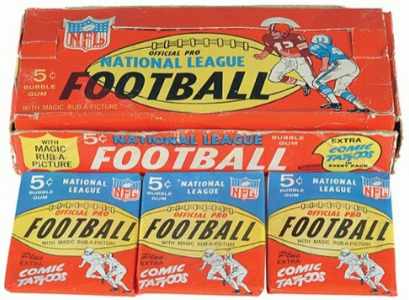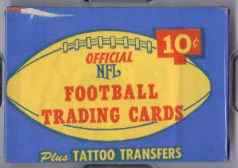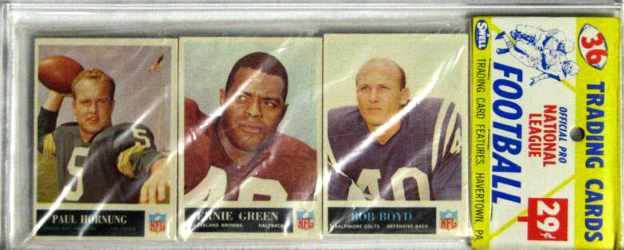1960 Fleer FB YELLOW PROOF & Regular #103 John McMullan
| Grade |
NM/MINT to EX/MINT |
| Book Value |
n/a |
| Our Price |
$ 29.95
Add to cart
|


Below are short bits & pieces on sportscard & baseball trading card collecting.
Please wander around the website for more info, prices, values & images
on vintage baseball, football, basketball, hockey, sport and non-sports cards.
1958 Topps Baseball Cards
Checklist & Values
In 1958 Topps started a continuing feature with their first "All-Star" subset.
A part of the All-Star subset, the Mickey Mantle 1958 All-Star card is famous
for being in the back pocket of famous sportscaster Bob Costas.
Click for complete
1958 Topps Baseball card checklist, values and prices.
Note: You may be on that page right now.
|

1970 Topps Baseball Cards
Checklist & Values
At 720 cards, the 1970 Topps set became there largest ever.
As is common with most Topps sets, the set was issued in
several series and as usual, the higher numbers ended up
being scarcer. The semi-hi's (#547 to #633) are scarcer
with the scarcest being the high #s (#634 to #720).
TOP ROOKIE was the Yankee's ill-fated catcher Thurman Munson.
Note: You may be on that page right now.
|

1965 Philadelphia Football

1965 was the 2nd year for Philadelphia Gum creating football cards.
Once again, their set had (198) cards, (14) from each team, featuring the rookie cards of
Hall-of-Famers Paul Warfield, Mel Renfro, Dick LeBeau, Carl Eller, Paul Krause and Charley Taylor.
1965 Philadelphia cards came in a variety of packages: nickel wax packs, ten-cent cello packs and 29-cent rack packs.
 Making this set a bit special was that for the first time in football card history, the NFL logo appeared on the front
of a card. The logo was Philadelphia Gum Company's way of sticking it to Topps as Philadelphia had the exclusive
to produce NFL cards while Topps was left to printing cards of the then 'lesser' AFL teams and players.
Making this set a bit special was that for the first time in football card history, the NFL logo appeared on the front
of a card. The logo was Philadelphia Gum Company's way of sticking it to Topps as Philadelphia had the exclusive
to produce NFL cards while Topps was left to printing cards of the then 'lesser' AFL teams and players.

Click for complete
1965 Philadelphia Football cards
Note: You may be on that page right now.
|

Baseball card collecting terms (part G)
Grade/Condition Centering, corner wear, photo clarity, edges,
creases, print flaws ... all combine to determine a card's condition or grade.
Along with rarity/scarcity it is the major factor in a card's value.
Graded Card As values increased the condition of cards and the
determination of fakes and alterations became increasingly more important.
Various companies became "graders" of your cards. For a fee they would grade
your card (usually on a 1 to 10 scale) and then placed in a sealed plastic
holder with labelling of the vital information.
From past experiences, most people are NOT HAPPY with the grades they receive.
To keep values up, graders can be extremely picky. Things you don't see,
they do so don't be surprized when the NEAR MINT card you send in ends up
with an EX or EX/MINT grade.
There are TOO many grading companies - if you do, do choose carefully.
PSA / SGC / GAI / BGS are some of the many companies.
It is good to know that getting a card graded by a company that people
do not recognize or respect will usually just cost you time and money
and not help you in any way.





 1965 was the 2nd year for Philadelphia Gum creating football cards.
Once again, their set had (198) cards, (14) from each team, featuring the rookie cards of
Hall-of-Famers Paul Warfield, Mel Renfro, Dick LeBeau, Carl Eller, Paul Krause and Charley Taylor.
1965 Philadelphia cards came in a variety of packages: nickel wax packs, ten-cent cello packs and 29-cent rack packs.
1965 was the 2nd year for Philadelphia Gum creating football cards.
Once again, their set had (198) cards, (14) from each team, featuring the rookie cards of
Hall-of-Famers Paul Warfield, Mel Renfro, Dick LeBeau, Carl Eller, Paul Krause and Charley Taylor.
1965 Philadelphia cards came in a variety of packages: nickel wax packs, ten-cent cello packs and 29-cent rack packs.
 Making this set a bit special was that for the first time in football card history, the NFL logo appeared on the front
of a card. The logo was Philadelphia Gum Company's way of sticking it to Topps as Philadelphia had the exclusive
to produce NFL cards while Topps was left to printing cards of the then 'lesser' AFL teams and players.
Making this set a bit special was that for the first time in football card history, the NFL logo appeared on the front
of a card. The logo was Philadelphia Gum Company's way of sticking it to Topps as Philadelphia had the exclusive
to produce NFL cards while Topps was left to printing cards of the then 'lesser' AFL teams and players.

